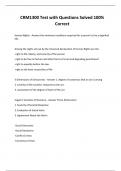Exam (elaborations)
CRM1300 Test with Questions Solved 100% Correct
- Course
- Institution
Human Rights - Answer the minimum conditions required for a person to live a dignified life. Among the rights set out by the Universal Declaration of Human Rights are the -right to life, liberty, and security of the person -right to be free of torture and other forms of cruel and degrading puni...
[Show more]



